
Part One: This Place Has Electricity!
by Paul Schatzkin
The story of television begins in Rigby, Idaho in the spring of 1919, as a small wagon train
reaches the crest of a hill overlooking a humble, turn-of-the-century homestead. The family of
Lewis and Serena Farnsworth has arrived at their new home, after an arduous journey over the
mountains from their native Utah.
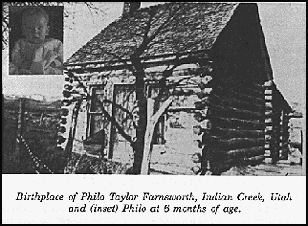 Seated at the reins of one of the three covered wagons was the oldest child,
Philo, age 11 and named after his grandfather, who came west with BrighamYoung.
As the boy surveyed the scene before him he noticed one detail which th erest
of the family missed: on the farm below, he could see wires nunning between
the different buildings and shouted excitedly, "This place has electricity!"
Seated at the reins of one of the three covered wagons was the oldest child,
Philo, age 11 and named after his grandfather, who came west with BrighamYoung.
As the boy surveyed the scene before him he noticed one detail which th erest
of the family missed: on the farm below, he could see wires nunning between
the different buildings and shouted excitedly, "This place has electricity!"
With this discovery, the family left the ridge and began their descent into a new life on the
frontier of the Twentieth Century. Little Philo was about to come face-to-face for the first time with the mysterious force he had only read about in books ,that invisible power that could drive great machines and turn darkness into light. Though he was about to encounter electricity for the first time at age 11, he would prove to be one of the great masters of that mysterious force before he was 21.
A few weeks after his arrival in Rigby,Philo had figured out all by himself what made the
electrical system work. Lewis Farnsworth realized that his son had a natural affinity for the
system when Philo stepped in one day to repair the disabled generator while all the adults stood
around wondering what had gone wrong. Thus, the boy-electrician became officially installed as
the chief engineer of the Farnsworth farm, and the electrical system became his own very special
domain.
With encouragement from his father, Philo found a dozen new uses for his invisible friend. He
built motors from spare partsand used them to run his mother's washin gmachine and some of
the farm machines.The time he saved by automating these chores he spent thinking about better
things. In the attic above the house, Philo created his own world to explore electricity in whatever books or journals his father could afford. The loft became his hide-away, where with each succeeding page, his imagination was fired by stories of science and the modern day sorcerers who unraveled its mysteries. To Philo, inventors of all kinds seemed to possess a special power that allowed them to see deep into the mysteries of nature and use her secrets to ease the burden for allmankind. He confided in his father his own heart's desire: that he, too, had been born an inventor.
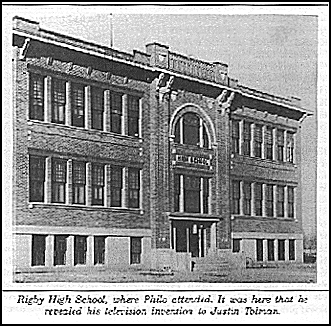 In the fall of 1921, Philo entered high school as a freshman but soon found
the material too dull, and cajoled his way into the senior chemistry class.
When even that advanced course proved inadequate for the youngster's thirst,
the chemistry teacher, a bespectacled and slightly passed- middle-age gentleman
named Justin Tolman, took extra time after class each day to tutor his young
prodigy. It became quickly apparent to Tolman that he was tutoring perhaps
the smartest student he would ever meet in his life.
In the fall of 1921, Philo entered high school as a freshman but soon found
the material too dull, and cajoled his way into the senior chemistry class.
When even that advanced course proved inadequate for the youngster's thirst,
the chemistry teacher, a bespectacled and slightly passed- middle-age gentleman
named Justin Tolman, took extra time after class each day to tutor his young
prodigy. It became quickly apparent to Tolman that he was tutoring perhaps
the smartest student he would ever meet in his life.
One cold night in January, 1922, Philo was particularly anxious to finish his chores after school
and hurry back to the books and magazines in his attic hideaway. As he turned the pages, he
stumbled upon an article about something very new: "Pictures That Could Fly Through the Air."
The writer described an electronic magi ccarpet, a marriage of radio and movies, that would
carry far-off worlds into the home in simultaneous sight and sound. Philo was instantly captivated
by the idea. He reread the article several times, convinced that he had stumbled onto a problem
that he was uniquely equipped to solve.
When Philo determined to learn everything he could about the subject, he stepped into a Jules-Vernian world where scientists were trying to convert light int oelectricity with the aid of whirling discs and mirrors. Farnsworth realized right away that those discs and mirrors would never whirl fast enough to transmit a coherent image, and searched for a device that could travel at the speed of light itself. He found the solution in his invisible new friend, the electron.
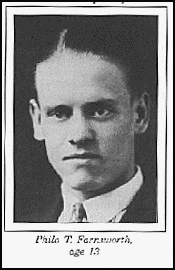 While the great minds of science, financed by the biggest companies in the
world, wrestled with 19th century answers to a 20th century problem, Philo
T. Farnsworth, age 13, was chained to a horse-drawn harvesting machine, crisscrossing
the fields endlessly, row by row, harvesting the crops and dreaming about
television to relieve the monotony. As the open summer sun blazed down on
him, a daring idea fermented in this boy's brain: He dreamed of trapping light
in an empty jar and transmitng it one-line-at-a-time on a magnetically deflected
beam of electrons.
While the great minds of science, financed by the biggest companies in the
world, wrestled with 19th century answers to a 20th century problem, Philo
T. Farnsworth, age 13, was chained to a horse-drawn harvesting machine, crisscrossing
the fields endlessly, row by row, harvesting the crops and dreaming about
television to relieve the monotony. As the open summer sun blazed down on
him, a daring idea fermented in this boy's brain: He dreamed of trapping light
in an empty jar and transmitng it one-line-at-a-time on a magnetically deflected
beam of electrons.
This principle still forms the heart of modern television.Though the essence of the idea is
extraordinarily simple, it eluded the most prominent scientists of the day. Yet here it had
crystallized in the mind of a 13-year-old boy.
It seems quite unlikely that an unknown boy with little education, no money, and no equipment
could steal the race from the greatest electrical companies in the world, but that is precisely what Farnsworth set out to do. His father advised Philo not to discuss his idea with anyone. Ideas, he reasoned, were too valuable and fragile, and could be pirated easily. But Philo had to talk to someone he needed to hear from somebody besides his father that his idea would work
Late one afternoon in March of 1922, Justin Tolman was startled to see a complicated array of
electrical diagrams scattered across the blackboard in his classroom. At the front of the room
stood his gangling young prodigy, chalking in the last few figures of the last equation and turning to his teacher.
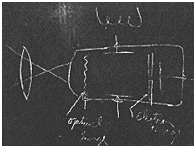 "What has this got to do with Chemisttry?" Tolman asked.
"What has this got to do with Chemisttry?" Tolman asked.
"I've got this idea," Farnsworth calmly replied. "I've got to tell you about it because you're the only
person I know who can understand it." The boy paused and took a deep breath. "This is my idea
for electronic television."
"Television?" Tolman said, "What's that?"
Farnsworth spent many hours with Tolman elaborating upon his idea. Weeks later, when the
semester ended, both Farnsworth and Tolman were convinced that the scheme would work.
Neither one would venture a guess when or how he could get a chance to prove it .
Hard times forced the family to leave the farm in Rigby in 1923 for more fertile soil near Provo,
Utah. Philo's father found work hauling freight over the mountains in mule-driven wagons.
Philo employed the same tenacity that had marked his career in high school in order to be
admitted as a special freshman to Bringham Young University. With the vast resources of a
major university at his disposal, he did his own private research about cathode ray tubes and
vacuum tubes. Still, with no money at his command there was little he could do to build an
operative model of the device that he could see so clearly in his mind's eye
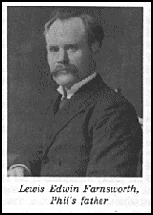 On one of his jobs just before Christmas 1923, Lewis Farnsworth was caught
in a violent snowstorm and contracted pneumonia. Philo was beckoned to his
father's death bed and charged with the responsility for taking care of the
family. Now calling himself "Phil" (the onslaught of manhood had compelled
him to start using a more conventional spelling of his name) he was forced
to leave BYU and take whatever jobs he could find. The likelihood of developing
his television ideas seemed remote at best.
On one of his jobs just before Christmas 1923, Lewis Farnsworth was caught
in a violent snowstorm and contracted pneumonia. Philo was beckoned to his
father's death bed and charged with the responsility for taking care of the
family. Now calling himself "Phil" (the onslaught of manhood had compelled
him to start using a more conventional spelling of his name) he was forced
to leave BYU and take whatever jobs he could find. The likelihood of developing
his television ideas seemed remote at best.
The Farnsworth family moved into half of a two family house in Provo. The other half of the
house was occupied by the Gardner family. Cliff, the oldest of the Gardner boys, was nearly the
same age as Philo and since the two boys shared a common interest in radio and things
electrical, they became close friends.
Along with two brothers, Cliff's family included six daughters. The prettiest of them was
Elma --everyone called her Pem-- who was only a year younger than Phil.
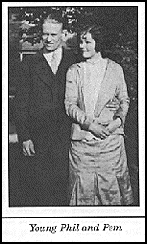 What time Farnsworth had to himself in the following months he spent with
Pem. It soon became apparent to both that they were meant to spend their lives
with each other. Phil proposed to Pem on her birthday in February, 1926, but
their youth and the uncertainty of their lives forced them to postpone setting
a wedding date.
What time Farnsworth had to himself in the following months he spent with
Pem. It soon became apparent to both that they were meant to spend their lives
with each other. Phil proposed to Pem on her birthday in February, 1926, but
their youth and the uncertainty of their lives forced them to postpone setting
a wedding date.
Phil and his future brother-in-law, Cliff, both subscribed to a correspondence course in Radio
maintenance, and in the spring of 1926 the two boys ventured off to Salt Lake City to start their
own business installing and repairing radios.
Unfortunately, in what was perhaps a precursor of things to come, Farnsworth's first attempt at running his own business did not fare well Out of desperation, Phil told Cliff that he was thinking about writing up his television ideas and submitting them to Popular Science Magazine. He thought that he might be able to make $100 if he worked it right. Cliff was familiar with Phil's daring ideas and shocked that he would consider disclosing them so publicly. He cautioned Phil that publishing might be a mistake he would regret. So Cliff returned to Provo and Phil signed up with the University of Utah placement service in hopes that they might find him work.
End of Part One
Continue with :
Part 2: The Daring of
This Boy's Mind!
This story is brought to you
as a public service by:
| 49chevy.com |
� 1977, 2001Paul Schatzkin; All Rights Reserved
For more information contact: The Perfesser
|